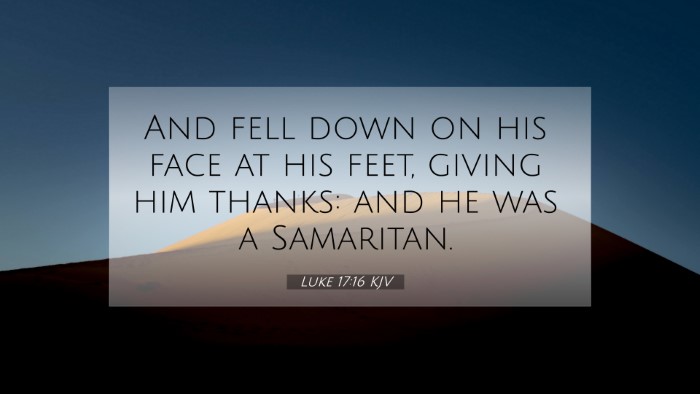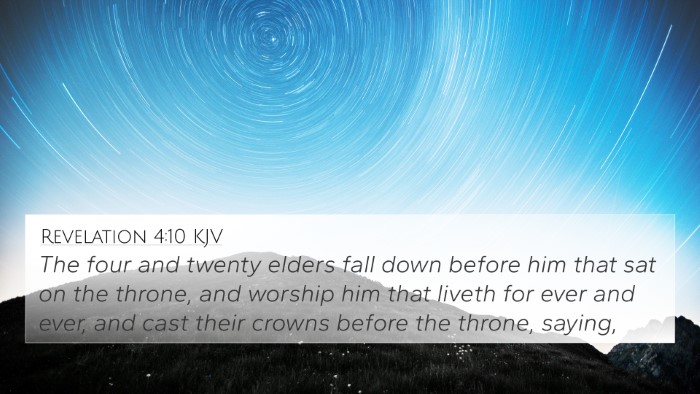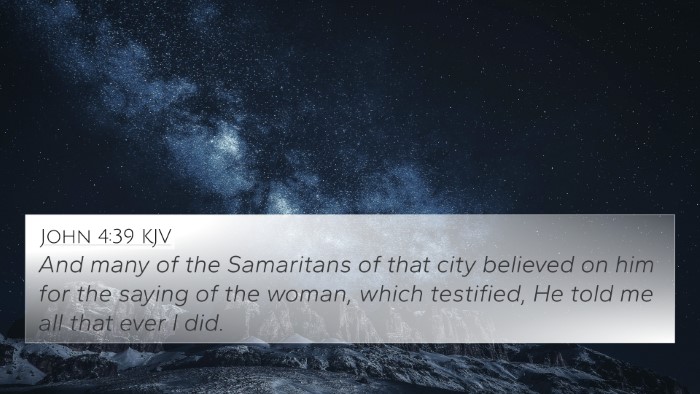Understanding Luke 17:16
In Luke 17:16, we find a profound moment in which the Samaritan leper, after being healed by Jesus, returns to express his gratitude. This brief yet powerful verse serves as a key lesson on the importance of thankfulness and recognizes the fulfillment of both physical and spiritual healing.
Verse Summary
The verse reads: "And he fell down on his face at his feet, giving him thanks: and he was a Samaritan." (KJV). In this action, we see deep humility and reverence from the Samaritan, contrasting with the behavior of the other lepers who did not return to give thanks.
Commentary Insights
Matthew Henry's Commentary
Matthew Henry emphasizes the significance of the Samaritan's actions. Despite being a social outcast, he demonstrates the essential quality of gratitude towards Jesus. This interaction highlights the Savior’s mercy and the importance of recognizing and responding to divine blessings. Henry notes that the leprosy, representing sin, is healed, shedding light on spiritual restoration.
Albert Barnes' Commentary
Albert Barnes points out the disparaging social context in which this healing takes place. The fact that a Samaritan—typically despised by the Jews—returns to express thanks underscores a theme of inclusiveness in Jesus' ministry. Barnes highlights that true faith and gratitude can be found in the least expected places, as this Samaritan exemplifies the proper response to God’s grace.
Adam Clarke's Commentary
Adam Clarke elaborates on the emotional and cultural implications of the Samaritan’s return. He reflects on how the act of falling at Jesus’ feet signifies total submission and appreciation for what has been received. Clarke stresses that the physical healing of the lepers symbolizes the spiritual healing available to all, regardless of societal boundaries.
Bible Verse Cross-References
- Luke 17:14 - Jesus instructs the lepers to go show themselves to the priests.
- 1 Thessalonians 5:18 - “In everything give thanks; for this is the will of God in Christ Jesus concerning you.”
- Romans 12:1 - Offers the idea of presenting ourselves as living sacrifices, thanking God for His mercy.
- Psalms 107:8-9 - “Oh, that men would praise the Lord for his goodness, and for his wonderful works to the children of men!”
- Luke 5:12-13 - Jesus heals a leper, showcasing His authority to cleanse.
- James 1:17 - “Every good gift and every perfect gift is from above, and comes down from the Father of lights.”
- Philippians 4:6 - Encourages believers to make their requests known to God with thanksgiving.
- Matthew 8:4 - Jesus instructs the healed to offer their gift to God as a testimony.
- Luke 10:33-34 - The Good Samaritan's compassion illustrates the theme of neighborly love.
- Matthew 11:28 - Jesus invites all who labor and are heavy laden to come to Him for rest.
Thematic Connections and Interpretations
The healing of the lepers in Luke 17:16 establishes a theme of gratitude that is prevalent throughout the Scriptures. The act of returning to thank Jesus not only signifies acknowledgement of His miraculous work but also exhibits a transformative understanding of faith. This verse encourages believers to cultivate a lifestyle of thankfulness that aligns with numerous biblical teachings on the importance of gratitude.
Connections Between Bible Verses
By examining this single verse, one can identify many connections with other Scripture passages that emphasize similar themes:
- Gratitude: Themes of thankfulness are reflected in passages like Psalms 95:2 and Ephesians 5:20.
- Healing and Restoration: Jesus' healing of the leper links firmly with Isaiah 53:5, signifying both physical and spiritual redemption.
- Samaritan Mercy: The act of the Good Samaritan provides a parallel narrative that amplifies the message of being kind and thankful.
Cross-Referencing Biblical Texts
When engaging in a cross-reference Bible study, one will find that Luke 17:16 serves as a pivotal verse in underscoring the relationships among various scripture themes. The interactions between Jesus and those he healed often carry deeper spiritual significance, allowing for comparative Bible verse analysis across different contexts in the Gospels.
Practical Application of Cross-Referencing
For individuals studying the Bible, utilizing tools for Bible cross-referencing can enrich one's understanding of how verses interrelate. In a deeper dive into the scriptures, one can identify how themes of healing, mercy, and gratitude connect to the broader narrative of salvation history.
Conclusion
Luke 17:16 invites deep reflection and gratitude for God's grace amid societal labels and expectations. By studying this and related verses, believers can better appreciate the thematic continuity of thankfulness throughout the Bible. The Samaritan's response not only sets an example of gratitude but also reminds us of the inclusive love of Christ that transcends boundaries.





















